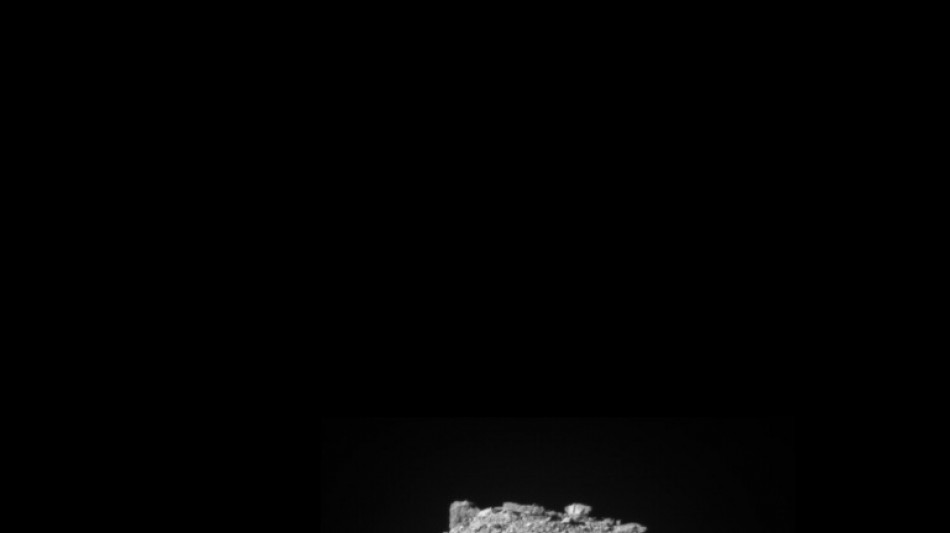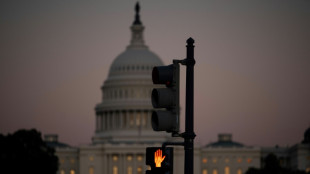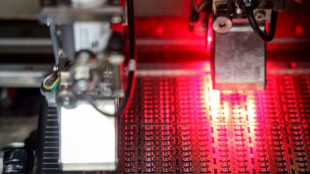
-
 US government shutdown may last weeks, analysts warn
US government shutdown may last weeks, analysts warn
-
Arsenal host Lyon to start new Women's Champions League format

-
 Gloves off, Red run, vested interests: Singapore GP talking points
Gloves off, Red run, vested interests: Singapore GP talking points
-
Bills, Eagles lose unbeaten records in day of upsets

-
 Muller on target as Vancouver thrash San Jose to go joint top
Muller on target as Vancouver thrash San Jose to go joint top
-
Tokyo soars, yen sinks after Takaichi win on mixed day for Asia

-
 China's chip challenge: the race to match US tech
China's chip challenge: the race to match US tech
-
UN rights council to decide on creating Afghanistan probe

-
 Indonesia sense World Cup chance as Asian qualifying reaches climax
Indonesia sense World Cup chance as Asian qualifying reaches climax
-
ICC to give war crimes verdict on Sudan militia chief

-
 Matthieu Blazy to step out as Coco's heir in Chanel debut
Matthieu Blazy to step out as Coco's heir in Chanel debut
-
Only man to appeal in Gisele Pelicot case says not a 'rapist'

-
 Appetite-regulating hormones in focus as first Nobel Prizes fall
Appetite-regulating hormones in focus as first Nobel Prizes fall
-
Gisele Pelicot: French rape survivor and global icon

-
 Negotiators due in Egypt for Gaza talks as Trump urges quick action
Negotiators due in Egypt for Gaza talks as Trump urges quick action
-
'My heart sank': Surging scams roil US job hunters

-
 Competition heats up to challenge Nvidia's AI chip dominance
Competition heats up to challenge Nvidia's AI chip dominance
-
UK police to get greater powers to restrict demos

-
 Guerrero grand slam fuels Blue Jays in 13-7 rout of Yankees
Guerrero grand slam fuels Blue Jays in 13-7 rout of Yankees
-
Five-try Bayonne stun champions Toulouse to go top in France

-
 Fisk reels in Higgo to win maiden PGA Tour title in Mississippi
Fisk reels in Higgo to win maiden PGA Tour title in Mississippi
-
Aces overpower Mercury for 2-0 lead in WNBA Finals

-
 Bayonne stun champions Toulouse to go top in France
Bayonne stun champions Toulouse to go top in France
-
Greta Thunberg among Gaza flotilla detainees to leave Israel

-
 Atletico draw at Celta Vigo after Lenglet red card
Atletico draw at Celta Vigo after Lenglet red card
-
Ethan Mbappe returns to haunt PSG as Lille force draw with Ligue 1 leaders

-
 Hojlund fires Napoli into Serie A lead as AC Milan held at Juve
Hojlund fires Napoli into Serie A lead as AC Milan held at Juve
-
Vampires, blood and dance: Bollywood horror goes mainstream

-
 Broncos rally snaps Eagles unbeaten record, Ravens slump deepens
Broncos rally snaps Eagles unbeaten record, Ravens slump deepens
-
Former NFL QB Sanchez charged after allegedly attacking truck driver

-
 France unveils new government amid political deadlock
France unveils new government amid political deadlock
-
Child's play for Haaland as Man City star strikes again

-
 India crush Pakistan by 88 runs amid handshake snub, umpiring drama
India crush Pakistan by 88 runs amid handshake snub, umpiring drama
-
Hojlund fires Napoli past Genoa and into Serie A lead

-
 Sevilla rout 'horrendous' Barca in Liga thrashing
Sevilla rout 'horrendous' Barca in Liga thrashing
-
Haaland fires Man City to win at Brentford, Everton end Palace's unbeaten run

-
 Haaland extends hot streak as Man City sink Brentford
Haaland extends hot streak as Man City sink Brentford
-
Italy working hard to prevent extra US tariffs on pasta

-
 Sinner out of Shanghai Masters as Djokovic battles into last 16
Sinner out of Shanghai Masters as Djokovic battles into last 16
-
Swift rules N. America box office with 'Showgirl' event

-
 Ryder Cup hero MacIntyre wins Alfred Dunhill Links on home soil
Ryder Cup hero MacIntyre wins Alfred Dunhill Links on home soil
-
Republicans warn of pain ahead as US shutdown faces second week

-
 Sevilla rout champions Barca in shock Liga thrashing
Sevilla rout champions Barca in shock Liga thrashing
-
Norris-Piastri clash overshadows McLaren constructors' title win

-
 Trump administration declares US cities war zones
Trump administration declares US cities war zones
-
Bad Bunny takes aim at Super Bowl backlash in 'SNL' host gig

-
 El Khannouss fires Stuttgart into Bundesliga top four
El Khannouss fires Stuttgart into Bundesliga top four
-
Insatiable Pogacar romps to European title

-
 Newcastle inflict more pain on Postecoglou, Everton end Palace's unbeaten run
Newcastle inflict more pain on Postecoglou, Everton end Palace's unbeaten run
-
Daryz wins Prix de l'Arc de Triomphe thriller


NASA kicked asteroid off course in test to save Earth
NASA on Tuesday celebrated exceeding expectations during a mission to deflect a distant asteroid, in a sci-fi like test of humanity's ability to stop an incoming cosmic object from devastating life on Earth.
The fridge-sized Double Asteroid Redirection Test (DART) impactor deliberately smashed into the moonlet asteroid Dimorphos on September 26, pushing it into a smaller, faster orbit around its big brother Didymos, NASA chief Bill Nelson announced.
That changed its orbital period by four percent, or 32 minutes -- from 11 hour 55 minutes to 11 hours 23 minutes, bettering an expectation of 10 minutes.
"At some point in the future, if we find an asteroid that is threatening to hit Earth, and would be large enough to really do some damage, thank goodness that we will have had this successful test," Nelson told AFP.
The asteroid pair loop together around our Sun every 2.1 years, and pose no threat to our planet.
But they are ideal for studying the "kinetic impact" method of planetary defense.
DART's success as a proof-of-concept has made a reality what was once science fiction -- notably films such as "Armageddon," "Deep Impact," and "Don't Look Up."
Never actually photographed before, Dimorphos, which is 530 feet (160 meters) in diameter or roughly the size of a big Egyptian pyramid, appeared as a speck of light around an hour before impact.
Its egg-like shape and craggy, boulder-dotted surface finally came into clear view in the last few moments, as DART raced toward it at roughly 14,500 miles (23,500 kilometers) per hour.
- Pseudo-comet -
In the days that followed, astronomers rejoiced in stunning images of matter spreading out thousands of miles -- pictures collected by Earth and space telescopes, as well as a tiny companion satellite that traveled to the zone with DART.
Thanks to its temporary new tail, Dimorphos has turned into a man-made comet.
But quantifying just how well the test worked required an analysis of light patterns from ground telescopes, which took a few weeks to become apparent.
The binary asteroid system, which was around 6.8 million miles (11 million kilometers) from Earth at impact, is visible only as a single dot from the ground.
The dot's brightness changes as Dimorphos passes in front of Didymos, which is significantly bigger at half-a-mile wide.
Four optical telescopes were involved in measuring the orbital period -- all in Chile and South Africa -- while two US based radar telescopes helped confirm the finding, said NASA planetary scientist Nancy Chabot.
The test also showed scientists that the asteroid is less like a solid rock, and more like a "rubbish pile" of boulders bound by mutual gravity.
If an asteroid is more solid, the momentum imparted by a spaceship will be limited. But if significant mass is pushed at high velocity in the opposite direction to impact, there will be an additional boost.
"It looks like the recoil from the ejecta blast off the surface was a substantial contributor to the overall push given to the asteroid," said NASA scientist Tom Statler at a briefing.
The test will serve as an "anchor point" for simulations and calculations about the outcome of future impacts, he added.
- Mass extinction -
No known asteroid larger than 140 meters (460 feet) in size -- big enough to devastate a city -- has a significant chance to hit Earth for the next 100 years, according to NASA.
But wait long enough, and it will happen.
The geological record shows, for example, that a six-mile wide asteroid struck Earth 66 million years ago, plunging the world into a long winter that led to the mass extinction of the dinosaurs along with 75 percent of all species.
The agency plans to launch in 2026 a telescope called the Near-Earth Object (NEO) Surveyor to better characterize potentially hazardous 140-meter asteroids and comets that come within 30 million miles.
So far, less than half of the estimated 25,000 NEOs of 140 meters have been discovered.
Kinetic impact with a spaceship is just one way to defend the planet, albeit the only method possible with current technology.
Should an approaching object be detected early, a spaceship could be sent to fly alongside it for long enough to divert its path via using the ship's gravitational pull, creating a so-called gravity tractor.
NASA believes the best way to deploy such weapons would be at a distance, to impart force without blowing the asteroid to smithereens, which could further imperil Earth.
R.Adler--BTB


